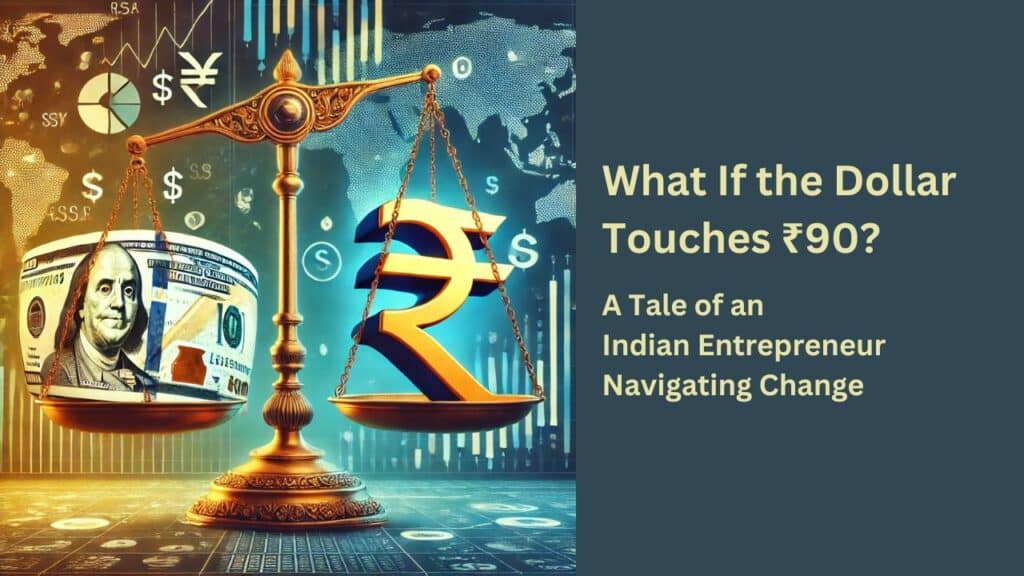What If the Dollar Touches ₹90?

A Tale of an Indian Entrepreneur Navigating Change
Meet Priya, a young entrepreneur from Bengaluru running a mid-sized textile export business. Like many Indian business owners, Priya keeps a close eye on the US Dollar (USD) to Indian Rupee (INR) exchange rate. But now, there’s news buzzing around that the Rupee might hit ₹90 against the Dollar. For Priya—and millions of others—this isn’t just a headline; it’s a game-changer.
Let’s walk in Priya’s shoes and see what this means for her business, her customers, and even her everyday expenses.
The Dollar Hits ₹90: A Mixed Bag for Priya
As an exporter, Priya knows a weaker Rupee makes her products cheaper and more attractive abroad. At first glance, this seems like fantastic news. Her clients in the US would be thrilled to pay less for her high-quality textiles, potentially boosting her orders.
But as Priya sits down to crunch the numbers, she realizes it’s not all rosy. Here’s what she’s juggling:
Winners in Priya’s World
- Export Boost: Good Times for Indian Goods
- Priya’s business is set to benefit immediately. Her textiles, priced in USD, are now cheaper for international buyers. She could even raise her profit margins without her clients batting an eye.
- Industries like IT, pharma, and agriculture are also celebrating. Priya’s brother, who works for a leading IT firm, tells her how companies like Infosys and TCS are likely to post record profits because of their USD earnings.
- Priya’s business is set to benefit immediately. Her textiles, priced in USD, are now cheaper for international buyers. She could even raise her profit margins without her clients batting an eye.
- Global Appeal for Indian Products
- It’s not just textiles—everything from Indian rice to spices is now a hot commodity globally. Priya’s friend, who runs an organic spice export business, is already preparing to scale up operations.
- It’s not just textiles—everything from Indian rice to spices is now a hot commodity globally. Priya’s friend, who runs an organic spice export business, is already preparing to scale up operations.
- A Stronger Travel Portfolio
- Priya dreams of exploring Europe but has postponed plans because of costs. However, as inbound tourism to India picks up (thanks to a weaker Rupee), she’s considering pivoting a small part of her business to create gift products for tourists.
Challenges Priya Must Tackle
- Imported Materials: The Price of Dependence
- Many of Priya’s premium fabrics rely on imported dyes and machinery. With the Dollar soaring, her costs are shooting up too.
- Her cousin in the electronics business is also worried. Importers of gadgets, machinery, and even luxury goods are feeling the pinch as their costs skyrocket.
- Many of Priya’s premium fabrics rely on imported dyes and machinery. With the Dollar soaring, her costs are shooting up too.
- The Fuel Factor
- Priya’s logistics costs are tied to fuel prices, and a weaker Rupee means pricier imports of crude oil. Every shipment she sends out or raw material she receives gets a little more expensive.
- Priya’s logistics costs are tied to fuel prices, and a weaker Rupee means pricier imports of crude oil. Every shipment she sends out or raw material she receives gets a little more expensive.
- The Domino Effect: Everyday Inflation
- Beyond her business, Priya notices groceries and household items becoming more expensive. Cooking oil, a major import, is burning a hole in her budget. Her employees are also feeling the heat, asking for raises to keep up with rising living costs.
Industries in the Spotlight
While Priya adapts, she sees other industries around her reacting in different ways:
Winners:
- IT and Pharma Giants: With USD earnings, these companies are smiling all the way to the bank.
- Export-Driven Sectors: From agri-products to gems and jewelry, the global market is ripe for Indian goods.
- Tourism: Priya’s hometown could see a boom in foreign visitors, offering new opportunities for her gift shop idea.
Losers:
- Oil and Gas Companies: Crude oil, imported in massive quantities, is now far more expensive.
- Automobiles: Car manufacturers dependent on imported parts are raising prices, dampening sales.
- Aviation: Airline tickets are going up as jet fuel becomes dearer, impacting both Priya’s potential vacations and her shipping logistics.
How Priya Plans to Stay Ahead
Priya knows she can’t control exchange rates, but she can control how she reacts. Here’s her game plan:
- Hedging Bets: Priya starts hedging her currency risks by locking in exchange rates for future transactions, protecting herself from sudden fluctuations.
- Local Sourcing: She’s exploring domestic alternatives for dyes and machinery, reducing her dependence on imports.
- Optimizing Costs: To manage rising logistics expenses, Priya negotiates better deals with shipping partners and embraces efficient packing methods to save space.
- Exploring New Markets: Encouraged by the favorable exchange rate, she begins tapping new international markets, diversifying her clientele.
What This Means for You
If you’re like Priya—a business owner, consumer, or even just someone curious about how global finance trickles down into daily life—this development matters. For every exporter benefiting, there’s an importer struggling. For every tourist finding India cheaper, there’s a commuter paying more at the petrol pump.
The Bigger Picture
For India as a whole, a Rupee touching ₹90 against the Dollar is both an opportunity and a challenge. It pushes the country to focus on domestic manufacturing, reduce import dependency, and strengthen its export ecosystem. For Priya, and countless others like her, it’s a time to adapt, innovate, and embrace change.
So, the next time you hear about the Rupee’s movement, remember—it’s not just a number on a forex chart. It’s a story of businesses thriving, challenges rising, and opportunities waiting to be seized.








Thanks for this insightful article and recommendations Rahul.